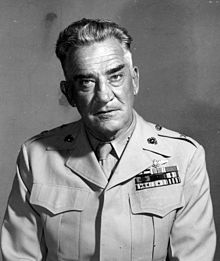Lawson H. M. Sanderson
| Lawson Harry McPhearson Sanderson | |
|---|---|

Sanderson as brigadier general, USMC.
|
|
| Nickname(s) | "Sandy" |
| Born |
July 22, 1895 Shelton, Washington |
| Died | June 11, 1973 (aged 77) San Diego, California |
| Place of Burial | Arlington National Cemetery |
| Allegiance |
|
| Service/branch |
|
| Years of service | 1917–1951 |
| Rank |
|
| Service number | 0-860 |
| Commands held |
Marine Air, West Coast 4th Marine Aircraft Wing 1st Marine Aircraft Wing Marine Aircraft Group 11 Marine Aircraft Group 42 |
| Battles/wars | |
| Awards |
Legion of Merit Distinguished Flying Cross |
World War I
Haitian Campaign
Nicaraguan Campaign
World War II
Lawson Harry McPhearson Sanderson (July 22, 1895 - June 11, 1973) was an aviation pioneer of the United States Marine Corps with the rank of major general. He is most noted for his effort in development of the Dive bombing technique. As Commanding officer of the 4th Marine Aircraft Wing, Sanderson accepted the Japanese surrender of Wake Island at the end of World War II.
He was born on July 22, 1895, in Shelton, Washington as the son of game warden Lewis Sanderson (1857-1941), and his wife Ruby (1861-1956). After attending the local high school, Sanderson enrolled at the University of Washington and subsequently at the University of Montana in Missoula, Montana, where he graduated with a Bachelor of Arts degree in 1917. He then enlisted in the United States Marine Corps on September 19, 1917 and subsequently served as Drill instructor with the rank of Gunnery sergeant. Sanderson requested Aviation training and was sent for instruction to Aviation Ground School at Cambridge, Massachusetts. He was subsequently assigned to the Marine Flying Field Miami, Florida in May 1918 and completed his aviation training at the beginning of January 1919.
...
Wikipedia
